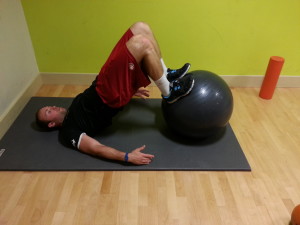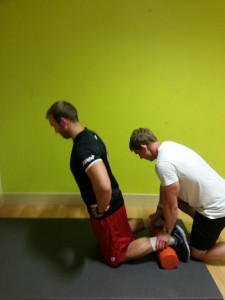Top 5 Hamstring Exercises
The hamstrings are a group of muscles located at the back of the upper leg, there are 3 muscles in the group; semi-membranosus, semi-tendinosus, and the bicep femoris. They act to flex the knee and help extend the hip as well as combining to assist rotation of the knee. The hamstring muscles also play a role in our posture by assisting to straighten out the lower curvature of the spine which curves the pelvis forward when sitting. The hamstrings work eccentrically to decelerate hip flexion (sprinting, kicking a ball, bending to touch your toes) and concentrically in the push off phase of gait. They are a common injury site amongst many athletes, predominantly due to an imbalance of strength between them, the glutes and the quadriceps group. As a result having a set of robust and strong hamstrings can help prevent you from injury. Try adding these exercises to your ‘leg day’ workouts.
Romanian Dead Lifts (straight leg dead lifts):
Holding either a bar or pair of dumbbells in an upright position, brace the core, keep the spine in neutral and begin to lower the weights down your legs by first pushing your butt backwards. Ensure you have ‘soft’ knees, continue lowering the weight until you have reached a point of full stretch in the posterior chain (hamstrings and glutes in this case), this should take 3-5 seconds to reach. Pause for a second maintaining a maximum brace on the core and neutral spine, begin extending the hips to stand up tall – you should feel like you are driving your heels into the ground – keep the bar travelling up close to the thighs and squeeze your butt into the bar at the top – this can be done quickly (1 second) or more slowly (3-5 seconds) dependant on training goal. Complete 3 sets of 12 reps with strict form to help maintain good hamstring and posterior chain health and fitness.
Start position is stood upright, core braced and neutral spine 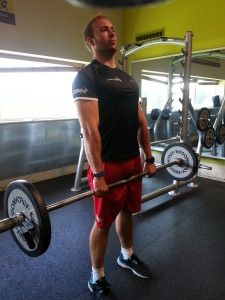
End point – bar lowered towards the ground, close the thighs, neutral spine and tight core, the feeling of the exercise should be one of a loaded stretch. 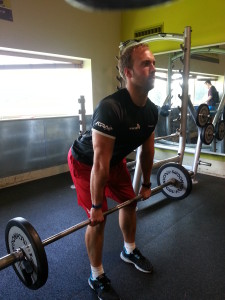
Swiss Ball Hamstring Curls:
An easier to complete exercise that can be done at home, the use of the Swiss ball however creates a great stability challenge transferring muscle activation through the hamstrings and utilising the core to again stabilise the spine and trunk. Lying on your back on the floor, place a Swiss ball under your calves. Firstly engage your core into a slightly flexed spinal position and squeeze your butt to lift your hips up towards the ceiling, thus creating a straight and neutral spine and body from feet to shoulders. Maintain this position as you pull your feet towards your butt and extend and slowly to the start position. Many variations of this exercise can be performed – single leg, super slow, fast curls or using other equipment such as a TRX to create varying challenges. As this exercise is a body weight controlled exercise, you can do a higher volume of reps to increase the workload – 3×15-20 reps will help keep those hamstrings strong and well integrated with the glutes and lower core musculature.
Start position, core braced, glutes firing to lift the hips, legs out straight.
End position, core braced, glutes firing to lift the hips, ball pulled in towards the butt.
Arabesques:
A great exercise stolen from the world of dance. This challenges the body to be on a single base, engage multiple other muscle groups, improve balance and co-ordination as well as health and strength of the muscle. The aim is to again brace the core before beginning the exercise. Standing on a single leg with a ‘soft’ knee, hinge at the hips but maintain a straight neutral spine, extend the non-grounded leg away from the body in line with your hips squeeze the butt and pull the toes back towards the head for an increased ‘tightening’ of the leg and core muscles. At the same time lower the chest towards the floor maintaining a good posture through the upper back and pinch the shoulder blades together. Reach the point of full stretch in the hamstrings of the grounded leg and return to an upright position. This is great exercise to use in a warm up as part of a dynamic stretch or as an individual exercise in strength training. Increased difficulty can be added via weights, additional movements of the arm, however the speed again can be enough to increase the stimulus to the hamstrings for increasing strength. Complete 3 x 10-15 reps each leg.
Start position, single base, neutral spine and a braced core 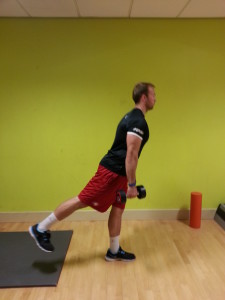
End position – straight back, toes pulled towards the head, slight softness in the knee
Nordic Hamstrings:
Arguably the toughest body weight hamstring exercise. Again eccentric loading is the primary focus of the exercise while it is really important to maintain pelvic alignment and core bracing. This exercise is also a partner assisted exercise – unless you have a glute-ham bench. Start in a kneeling position with your body upright (core braced, neutral spine), your partner then needs to hold your legs just above the ankles – a foam roller or cushion underneath is ideal so as to not place the ankle into forced plantar flexion – your partner needs to hold you down hard as this is the anchor of the pivot. Slowly begin lowering your body towards the floor, chest first, without ‘breaking’ or bending at the hips. You will only be able to hold the load for so long, but fight to hold the lowering for 4-5 seconds. There are a few options to this exercise at this point – you can either fall to the floor and return to the start position to begin another eccentric only repetition, you could spring back up to the start position after falling using a push up and your hamstrings or for the strongest athletes out there you can pull yourself back to the start position using just your hamstrings. This is a tough exercise and definitely induces DOMS so should not be done in under 72 hours before competition. Things to watch out for are – making sure the glutes fire to hold pelvic alignment, checking for any torsion or twisting to help generate force – this highlights a muscle imbalance somewhere in the chain and to make sure the athlete isn’t in lumbar extension or hip flexion. A tougher exercise, you can start with band assisted reps and progress to adding a weight jacket if an increased overload is needed. Try 3×6 to start, progress up to 3×12.
Lower body down towards the floor 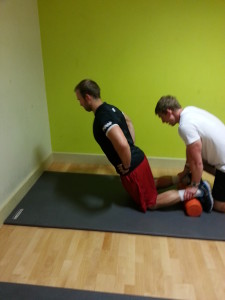
Downhill Running – deceleration drills
Often when you see a hamstring injury occur it is during the deceleration phase of a sprint, where the hamstring comes under the greatest load. Often this is caused by a lack of strength or a muscle imbalance – the above exercises can help with the strengthening. However it is also important to practice movement based exercises if you are an athlete. This is where deceleration drills and landing mechanics become really important. There are hundreds that you could choose from, so I will give a few specific examples:
Landing from a box – start with a low height and practice landing in a solid position, knees bent, straight back, weight on the mid foot, quiet landing by using the leg muscles to ‘absorb’ the landing. Progress to higher boxes or weighted squat jumps with a landing.
Sprinting and then slowing down – sounds simple but worth practicing, build up gradually into a sprint 20-60m is ideal before working on coming to a stop as quickly as possible after a given point or line or on the reaction of ‘stop’ call from a partner. Ensure that as you decelerate, you lower your centre of mass by bending the knees, widening the base and keeping a straight back, weight should be mid foot still.
Downhill running – firstly don’t choose a hill that’s too steep or too short. Secondly you need to actively run/sprint down the hill. The slope will cause a breaking effect by using the hamstrings and glutes to try to slow you down. Start slow and build up gradually.
Extra-time:
Finally and importantly as you can see there is a common trend in the strengthening process – to focus on the eccentric phase of muscle contraction. With this is mind some of your more well-known strength training exercises can also be excellent strengtheners of the hamstrings. Try eccentric based squats – a slow 5 second descend and a 2 second pause at the bottom of the squat before returning to an upright position will add volume to your leg session. Start with a manageable weight and have a spotter on hand; 4 x 10-12 will do the trick. Split squats or rear foot elevated lunges, again a slow descent will target the legs as a whole but will definitely help strengthen the hamstrings.
Similarly explosive power work will help as the body will learn to decelerate the movement efficiently for landing and changes of direction. The same principles of learning good technique, starting at light loads and intensities and building from there will ensure the best results and keep the risk of injury to a minimum. This is also where having a strength and conditioning coach becomes a great advantage so they can review technique, loading and intensity of training.
Happy Hamstring Training.
Fabrizio Gargiulo


